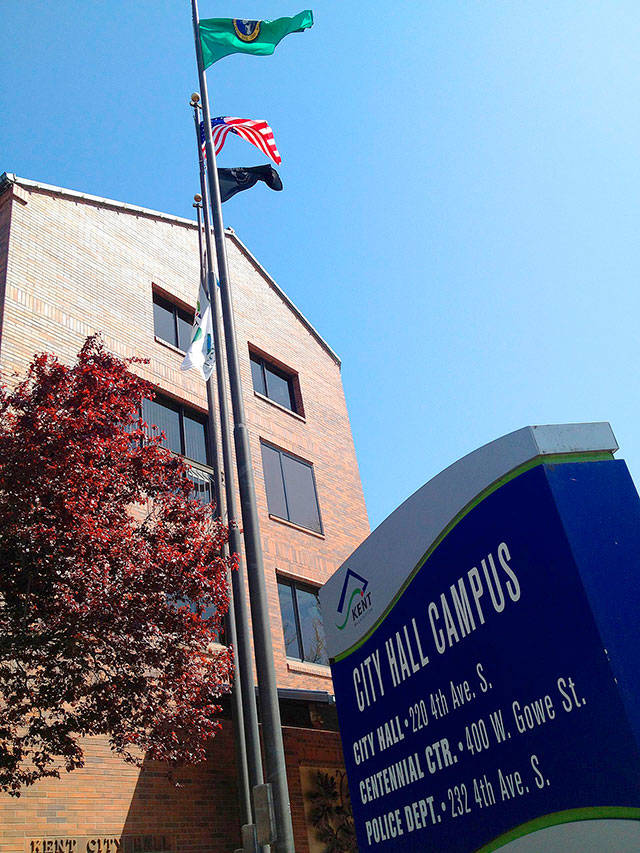The sky is no longer falling when it comes to the city of Kent budget.
“No more fiscal cliff,” Council President Bill Boyce said after hearing a 2018 Year-End Financial Report from Interim Finance Director Barbara Lopez at the May 7 council workshop.
City leaders used the fiscal cliff term to describe Kent’s potential loss of nearly $5 million per year in streamlined sales tax mitigation funds and the loss of $4.5 million in annexation sales tax credit starting in June 2020 for the 2010 Panther Lake annexation. The state set up a 10-year funding program to help the city take on more residents.
“We need to take a moment to pause – 2018 was a phenomenal year for us,” Boyce said. “From the mayor to the council members to the leadership team, we have done a phenomenal job for where we ended up at. We had some major hurdles to go through along the way, but kudos to everyone on the team. This is really setting us up. There are still bumps in the road ahead of us, but the way ended up in 2018, kudos to our team.”
The city’s general fund tax revenue of $110 million in 2018 was $7.9 million above budget, according to city documents. Sales tax revenue came in $3.5 million above budget. Other tax revenue (including B&O tax, permit fees) came in $3.1 million over budget.
The city’s spending of $109.3 million came in $189,844 under budget. About 50 percent ($54.4 million) of expenses were for salaries and benefits.
“When you are over in revenues and under in expenses, that is what you like to see,” Lopez said.
As far as the potential loss of state revenue, the city received a boost this year when the Legislature decided to continue the streamlined sales tax mitigation funds to Kent for at least two more years. The council plans to put that money in the capital budget but has yet to determine how the funds will be spent.
The streamlined sales tax mitigation funds were set up by the state to help compensate Kent for revenue lost when legislators changed the state in 2008 from an origin-based system for local retail sales tax to a destination-based system, taking away city tax revenue from its many warehouses.
Tax revenue up
Lopez said increased construction activity in the city boosted sales tax revenue.
“It’s largely due to construction,” said Lopez, who added one-time projects such as the YMCA on the East Hill and the Marquee on Meeker Apartments were not budgeted because those are one-time projects but when built contribute extra revenue.
Permits and license fees also were up with additional development and construction.
“We don’t budget those fully because we can’t rely on the big project coming in every year,” Lopez said.
Property taxes bring in about 27 percent of the city’s revenue, sales taxes 21 percent, utility taxes 18 percent and the rest is from smaller taxes (B&O 9 percent, licenses and permits 7 percent and other taxes).
The council voted in 2017 to use banked property tax capacity to help raise property tax revenue to $29.9 million in 2018, about $7 million higher than in 2017.
Kent had banked capacity (or money saved from taxes not levied) because the city reduced its property tax levy by $1.00 per $1,000 assessed valuation in 2011 after voters in 2010 approved the formation of the Kent Fire Department Regional Fire Authority (now Puget Sound Fire), which levies a property tax of $1.00 per $1,000 assessed valuation. The use of banked capacity allowed the city to raise property taxes above the 1 percent annual state cap imposed by Initiative 747 approved by voters in 2001.
The council in 2018 also approved higher B&O rates starting in 2020 and increasing in the following years to help make up for the expected loss in state funds.
Fund balance of $21 million
Kent has a general fund reserve balance of $21.6 million or 19.8 percent of the general fund budget. The council approved a requirement that at least 18 percent of the general fund must be placed in reserves.
The city’s healthy financial position has resulted in strong bond ratings from Standard & Poor’s (AA+) and Moody’s (Aa3). The Standard & Poor’s rating is the second highest possible. Moody’s considers Kent a very low credit risk.
“It is like a personal credit score,” Lopez said. “The higher the credit (rating) that we have than the better rates we get if we do borrow anything.”
Lopez told the council the structural imbalance still exists where revenue typically cannot keep up with expenses (and the higher costs) because of the state’s property tax increase limit of 1 percent per year by cities. She said that potential shortfall will be looked at with the 2020 budget, which the mayor will propose in October and the council will vote on in November.
Boyce summarized the financial report at the May 7 council meeting.
“Overall, 2018 was a very strong year for the city mainly because of lots of development and construction activity going on and that really boosts our revenue,” Boyce said. “We no longer have the fiscal cliff that we have been worrying about for so long. We had to made some adjustments last year so the fiscal cliff is no longer a problem. But we still have a structural imbalance where our expenses outweigh our revenue, so as we go forward we have to make sure we plan for that.”
Talk to us
Please share your story tips by emailing editor@kentreporter.com.
To share your opinion for publication, submit a letter through our website https://www.kentreporter.com/submit-letter/. Include your name, address and daytime phone number. (We’ll only publish your name and hometown.) Please keep letters to 300 words or less.

